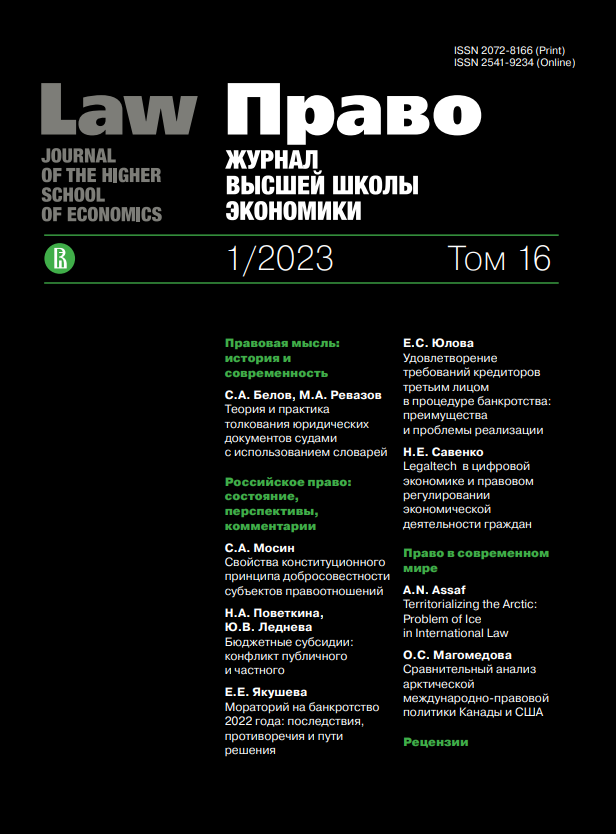Establishing Servitude in Order to Place Infrastructure Facility of Federal or Regional Significance
Abstract
The article is based on the results of the comprehensive research on the law enforcement monitoring involving specialists in various fields of knowledge, namely lawyers and economists. The author considers the problems of defining the concepts of «infrastructure facility of federal significance», «infrastructure facility of regional significance», “servitude”; some aspects of the state cadastral registration and state registration of rights in relation to infrastructure facilities of federal or regional significance; the grounds for placing infrastructure facilities of federal or regional significance on public and private land lots, public lands; the recourse mechanisms of the interests of right holders of land lot on which infrastructure facilities of federal or regional significance are located. Mostly, the article contains a legal view of the issues mentioned. However, since the article is based on the results of interdisciplinary law enforcement monitoring, it also presents some economic aspects. On the basis of the research results, the author, in particular, concludes that the legal definitions of the concepts «infrastructure facility of federal significance» and «infrastructure facility of regional significance» can obtain relevant content in relation to an economic analysis of the phenomena. The special characteristics of infrastructure facilities of federal or regional significance inevitably determine the specifics of the registration of rights in relation to such objects and land lots on which they are located. However, not all the identified features can be assessed positively. For example, in the author's opinion, regardless of whether an infrastructure facility is located on / above / under someone else's land lot, the right to place the object should be issued. As to the appropriate title to the placement of infrastructure faculties of federal or regional significance on someone else's land lot, if earlier a land lease was most in demand, today it is a public servitude established according to the rules of Ch. 7 of the Land Code of the Russian Federation. Meanwhile, the use of the concept of servitude for the designated purposes still causes many theoretical and practical issues, as it is evidenced by enforcement practices.
References
Averyanova N.N. (2015) New legislation on land easements. Pravo i ekonomika=Law and Economics, no. 2, pp. 63-67 (in Russ.)
Bevzenko R.S. (2019) The commentary on Art. 8.1 of the Russian Civil Code (part 1). Vestnik ekonomicheskogo pravosudia=Bulletin of Economic Justice, no. 11, pp. 127-169 (in Russ.)
Depoorter B., Parisi F. (2003) Fragmentation of property rights: a functional interpretation of the law of servitudes. Olin Centre for Studies in Law, Economics and Public Policy. Working Paper no. 284, pp. 1-41. DOI: https://doi.org/10.2202/1535-1653.1081
Galinovskaya E.A., Boltanova E.S., Volkov G.A. et al. (2020) Zones with special conditions for using territories. Establishment and observance of the legal regime. Moscow: INFRA-M, 304 p. (in Russ.) DOI: https://doi.org/10.12737/1080400
Gallo P., Natucci A. (2001) Beni proprieta e diritti reali. Torino: Giappichelli, 272 p. (in Italian)
Goronovich I. (1883) A study in easements. Saint Petersburg: Printing House of the Senate, 107 p. (in Russ.)
Megarry R., Wade W. (2012) The law of real property. London: Sweet and Maxwell, 1668 p.
Muromtsev SA (2003) Civil law in the ancient Rome. Moscow: Statut, 685 p. (in Russ.)
Nardi E. (1997) Codice Civile e diritto Romano. Gli articoli del vigente codice civile nel loro precedenti romanistici. Milano: Giuffre, 130 p. (in Italian)
Rudokvas A.D. (2009) Private easements in the Russian civil law. Vestnik Vyshgego Arbitrazhnogo Suda=Bulletin of the Higher Arbitration Court, no. 4, pp. 186-205 (in Russ.)
Shanygin S.I., Zuga E.I. (2019) Statistics on allocation of infrastructure facilities in Russia (territorial and economic aspects). Ekonomika i upravlenie =Economy and Management, no. 7, pp. 38-48 (in Russ.) DOI: https://doi.org/10.35854/1998-1627-2019-7-38-48
Trabucchi A., Cian G. (2005) Commentario breve al Codice Civile. Padova: CEDAM, 3862 p. (in Italian)
Yemelkina I.A. (2010) Property (real) easements in Russian law and foreign legal systems: development trends. Khozyaistvo i pravo=Economy and Law, no. 12, pp. 85-91 (in Russ.)
Yiannopoulos A.N. (1968) Predial Servitudes; General Principles: Louisiana and Comparative Law. Louisiana Law Review, vol. 29, no. 1, pp. 1-45.
Zharkova O.A. (2019) Registration of rights to infrastructure facilities. Imushstvennye otnoshenia v Rossii=Property Relations in Russia, no. 12, pp. 43-55 (in Russ.)
Zhestovskaya D.A. et al. (2021) Private and public easements in cadastral valuation of land plots. Vestnik ekonomicheskogo pravosudia=The Bulletin of Economic Justice, no. 1, pp. 82-98 (in Russ.) DOI: https://doi.org/10.37239/2500-2643-2021-16-1-82-98
Copyright (c) 2023 Law Journal of the Higher School of Economics

This work is licensed under a Creative Commons Attribution-ShareAlike 4.0 International License.





